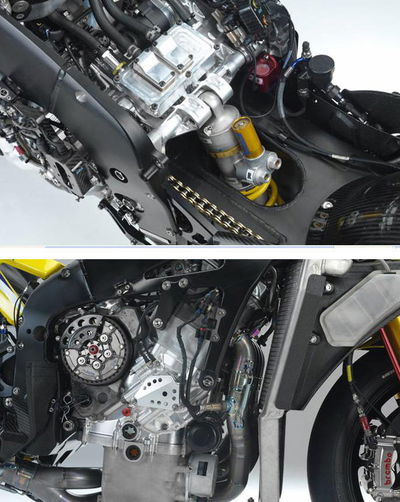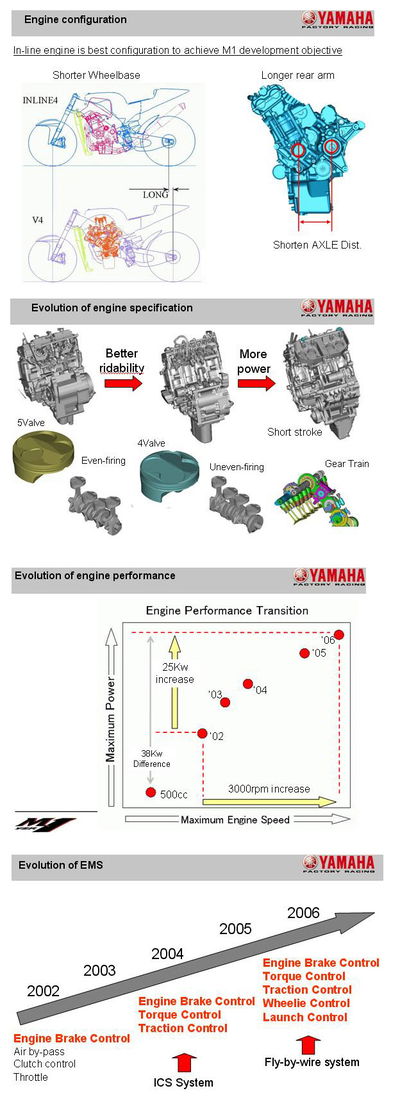Evolution of the YZR-M1 - part two.
Part one of the Yamaha technical presentation detailed how the YZR-M1 has evolved since its 2002 racing debut, and part two will now concentrate specifically on the 2006 machine.
Despite the 2005 YZR-M1 having taken a perfect sweep of the riders', constructors' and teams' world championships, the 2006 machine initially struggled with chatter, before a storming fight back during the second half of the season put reigning champion Valentino Rossi in the title lead for the Valencia season finale...

Part one of the Yamaha technical presentation detailed how the YZR-M1 has evolved since its 2002 racing debut, and part two will now concentrate specifically on the 2006 machine.
Despite the 2005 YZR-M1 having taken a perfect sweep of the riders', constructors' and teams' world championships, the 2006 machine initially struggled with chatter, before a storming fight back during the second half of the season put reigning champion Valentino Rossi in the title lead for the Valencia season finale...
"As you know, we had a great season in 2005. So our development target for 2006 [see middle picture, click to enlarge] was to keep the same concept as 2005 but to improve the chassis agility a bit more and increase braking stability," revealed YZR-M1 project leader Koichi Tsuji, before commenting on development targets for the two other main 'themes' - engine and Engine Management System (EMS).
"For the 2006 engine, we again had to have more power and revs," he said. "For the EMS, we had difficulty in handling the two-by-two ICS [Idle Control System]. So, to achieve easier set-up at the race track, we started to develop the fly-by-wire system."
In order to achieve these goals, the following modifications to the 2005 bike were undertaken (middle picture, 'Modification from 2005'):
"With the chassis, we slightly stiffened the rear suspension mounting to have better control for tyre performance," said Tsuji. "On the engine, we changed to a shorter stroke than used in the 2005 engine and achieved more power and revs. For the EMS, we developed a fly-by-wire system to control more parameters.
"These items were working OK and we started this season..."
But Yamaha soon hit chronic chatter problems with the new chassis - prompting three stages of chassis modification throughout 2006 although, perhaps surprisingly, the engine was also upgraded on four occasions.
"This chart [middle picture, '2006 Development flow of YZR-M1'] shows the development stages throughout the 2006 season," said Tsuji. "We changed the chassis three times and the engine four times.
"As you know, we had a chassis problem at the start of the season with chattering. Through this period, we gathered a lot of data and modified the chassis. From Le Mans, we started to use the chassis to countermeasure chatter. This chassis was third generation.
"This chassis did not have chatter but we struggled to set up the chassis because we had to throw away all the data from the winter tests [with the previous chassis]. After the Brno GP, we modified the new chassis again and this one we used from Sepang onwards.
"For the engine, we concentrated on developing the best balance between power and fuel economy. We gained approximately five horsepower and 400rev/min more with the same fuel economy [compared with 2005]."
Of course, Rossi and Yamaha were ultimately denied the 2006 title when the Italian fell at the Valencia finale - handing Nicky Hayden and Honda the world championship - but Rossi and the new 800cc Yamaha will be seeking revenge next season.
Speaking in conclusion, Tsuji underlined the most important aspects learnt during the 990cc M1 era.
"The YZR-M1 was designed and developed to achieve the best handling. This concept feeds back to production bikes like the YZF-R1 and YZF-R6," said Tsuji.
"The adaptation of 'uneven-firing' technology to the in-line four cylinder engine has made a big improvement in rideability. This technology is spreading in MotoGP.
"Through 2002 - 2006 the engine management system has seen a lot of progress. Each year sees an increase in the number of items on the bike that are controlled by the EMS system."
Yamaha, like its main rivals, has already begun track testing of its new 800cc machine, which will be raced for the first time at the Qatar Grand Prix on March 10, 2007.












